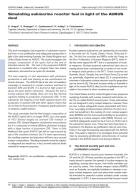Details
- Identification
- ISSN: 1977-5296, DOI: 10.3011/ESARDA.IJNSNP.2023.4
- Publication date
- 25 October 2023
- Author
- Joint Research Centre
Description
Volume: 65, December 2023, pages 34-43
Authors: Sophie Grapea, Erik Brangera, Cecilia Gustavssona, Robert Kelleyb and Vitaly Fedchenkob
aUppsala University, Department of Physics and Astronomy
bStockholm International Peace Research Institute
Abstract: This work investigates fuel properties of submarine reactor fuel from a non-proliferation and safeguards perspective in light of the deal involving Australia, the United Kingdom and United States known as AUKUS. This study investigates the isotopic composition of the spent fuel at the end of intended reactor life. The fuel in the proposed AUKUS submarine is modelled after a Virginia Class fast attack submarine, discussed as an option for Australia.
The vast majority of civil experience with plutonium production is with fuel starting at low enrichments for shorter burnups. The AUKUS fuel at the start of irradiation campaign is assumed to contain uranium enriched to between 93% and 97,3%. It is burned at high power for about 33 years before retirement. Because the fuel is mostly uranium-235 initially, there are very few thermal captures leading to production of plutonium-239. In the submarine, the majority of non-fissile captures lead to the production of uranium-236 with other capture chains that do not lead to the production of weapons grade plutonium or weapons usable uranium.
This study concludes that the final isotopic composition of the AUKUS spent fuel is no longer VHEU, but a low grade of HEU diluted largely by uranium-236 instead of uranium-238. Several kilograms of plutonium are produced but it is composed of several different plutonium isotopes with a large fraction of plutonium-238. There is little likelihood that spent AUKUS fuel will be reprocessed by any of the countries involved. But if it were reprocessed, the resulting uranium and plutonium will have very unusual isotope compositions. Resulting materials would be subject to safeguards but would not, in fact, be well-suited as fissile material for weapons purposes.
Keywords: AUKUS, non-proliferation, safeguards, submarine, reactor fuel
Reference guideline:
Grape, S., Branger, E., Gustavsson, C., Kelley, R., & Fedchenko, V. (2023, December). Simulating submarine reactor fuel in light of the AUKUS deal, ESARDA Bulletin - The International Journal of Nuclear Safeguards and Non-proliferation, 65, 34-43. https://doi.org/10.3011/ESARDA.IJNSNP.2023.4

